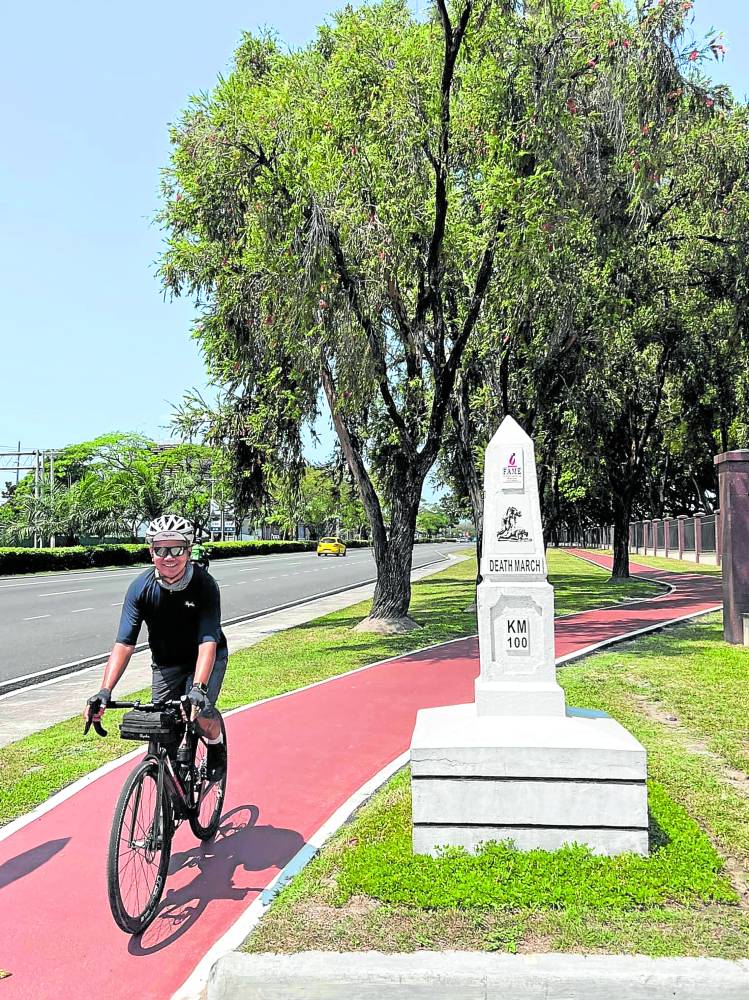Cost of mobility: Philippines promises to pave better road networks for bikers

SAFE HAVEN Clark is a favorite playground of bikers with its dedicated cycling lanes and smooth roads. —Max Narvaez/CONTRIBUTOR.
(Second of a series)
Christine Saavedra bikes to work once a week and every time, the 29-year-old business systems analyst has to overcome several bumps on the road, so to speak.
On the route from her home in Mandaluyong to an insurance company office in Bonifacio Global City, she always encounters an exposed manhole—which makes the path uneven—near a fast food establishment by Pioneer St. Saavedra just slows down every time she passes by to ensure her safety.
But this is just one of the things that trouble her. There are also motor vehicles cutting into the cyclists’ dedicated roads, she says, noting that the lack of physical separators on the cycleways is a concern as well.
Generally, Saavedra does not feel safe biking around but it is a risk she’s willing to take for the sake of convenience. “It is just the easiest way for me to get around. If I were to continue commuting to my office, it would take more than an hour,” she tells the Inquirer. It only takes her less than half an hour cycling to work.
“What if the MRT (Metro Rail Transit) breaks down?” she adds, explaining that biking affords her assurance of mobility. She believes that other bikers are likely to share the same sentiment.
With more cyclists on the road, there have been louder calls to expand bike lanes, upgrade the infrastructure, improve road safety and implement policies to make active transport a viable option in the long run.
Wanted: Longer bike lanes
According to the Department of Transportation (DOTr), the country has 564 kilometers (km) of bike lanes, majority or 313.12 km of which are in Metro Manila. Others are built in Metro Cebu and Metro Davao.
Robert Siy, co-convener of transport advocacy group Move as One Coalition (MAOC), tells the Inquirer these are not enough to address the growing interest in cycling as a form of public transportation.
A 2022 survey by the Social Weather Stations notes that one in four Filipino households owns a bike and about 30 percent have at least one family member biking for essential or leisure purposes.
The existing bike lanes are “just scratching the surface,” he says. Siy suggests that at least 25 percent of the national and local roads—spanning over 180,000 km in total—should have protected bike lanes.
“While the number might be presented as a big number, on the ground, it doesn’t present a proper network,” Ira Cruz, director of transport group AltMobility PH, says in an interview with the Inquirer.
Across the regions
The DOTr has allotted P2 billion this year to construct additional 470 km of roads dedicated to cyclists, which cover Metro Manila and Regions I, III, IVA, V, VI, VII, VIII and XI.
Eldon Dionisio, DOTr Active Transport Program manager, tells the Inquirer the agency eyes to complete the project this year.
“Aside from the metropolitan areas, we are now expanding to other emerging urban areas as well and key tourist destinations,” he says. When it comes to bike lane construction, Dionisio points out that the focus has been in high density areas to alleviate heavy traffic.
In March, the government inaugurated the construction of 9.6 km of bike lanes and pedestrian walkways in Intramuros, Manila. Siy, in relation to this, raises the need for the government to allot P20 billion to P30 billion for active transport initiatives in the next 10 years to enable construction of high-quality infrastructure.
“Building continuous networks of sidewalks and bike lanes throughout a city enables more people to travel independently, at much lower cost, with minimal environmental impact and with more predictable travel times,” he stresses.
Quality infrastructure, too
While the rollouts are set in motion, Dionisio says that DOTr is also focusing on improving the quality of the existing bike lanes for better road experience.
The DOTr official cites the need to widen the bike lanes and pave the roads to eliminate hazardous potholes. In addition, Dionisio says more traffic-calming measures like speed bumps must be placed where the flows of motorists and bikers or pedestrians intersect.
“The infrastructure needs some improvement. We chose progress over perfection,” he explains, noting they had to build bike lanes immediately due to public necessity.
Now, the DOTr is working on upgrading the class levels of existing bike lanes by a notch, apart from forging on with the expansion plan.
Bike roads are classified into three categories. Class 3 lanes, which are marked by broken lines on the road, are the least protected as these are still shared with motor vehicles. Class 2 lanes are separated by pavement marking and/or physical separators but are still on the carriage way. Class 1 lanes, which Dionisio describes as the “most ideal,” are completely separate from the main roads.
For safety, convenience
Siy, a transport economist, stresses the need to put up physical barriers along the bike lanes so cyclists will feel safer while passing through them.
“Bike lanes should have physical barriers or grade separation so that motor vehicles are prevented from mixing with cyclists in these lanes,” he explains.
The MAOC co-convener, in addition, says that planting trees along the pathways can make the biking experience better as these can keep the areas cool and shaded.
“We should also seek to place bike lanes on roads that offer cyclists and pedestrians the most direct route. Because bicycles are moving on human energy, they deserve to be on the shortest paths,” Siy shares.
Cruz, meanwhile, raises the need to build more end-of-trip facilities for the cyclists.
“It is not just about being able to bike on the road, but making sure also that when you arrive at the destination, there is bike parking,” he points out. INQ
(To be concluded)
